In previous posts, I mentioned my preference for keeping the bird feeders in a squirrel-free zone. We have been here in Maine for five years as of last month. I had lucked out for a while, without the feeders being taken over by squirrels. It wasn’t until about a couple of years ago, that I had my first eastern gray squirrel Sciurus carolinensis invade my feeders. Since then, the word must have spread among the rodent family Sciuridae, because I now have several troublemakers trying to sneak food from the feeders every chance they get. Members of this troublemaker family include eastern gray squirrels Sciurus carolinensis, flying squirrels Pteromyini or Petauristini, eastern chipmunk Tamias striatus, and my most recent visitor, the American red squirrel Tamiasciurus hudsonicus.
For a few months now, I have only had to deal with two American red squirrels coming to the feeders on occasion. The number of these squirrels has increased these past weeks and as of yesterday, there are now seven American red squirrels coming to the feeders. That’s right, folks, I said seven American red squirrels! It has been quite entertaining watching this group of squirrels and how they all interact with each other. Groups of American red squirrels are also known as “dray” or a “scurry.” As of late, there has been a lot of chasing, fighting, verbal disagreements, and in general, a lot of bad behavior. In this post, I would like to share a few photographs of these squirrels and their activities as well as some information on the American red squirrel.
In order to deter the squirrels from getting into the feeders, I have been putting some bird seed out on the ground and this seems to work out most days. This practice has also helped in feeding the birds that don’t like to use the feeders on a regular basis, such as some of the mourning doves Zenaida macroura and dark-eyed juncos Junco hyemalis. They would rather stay close to the ground.
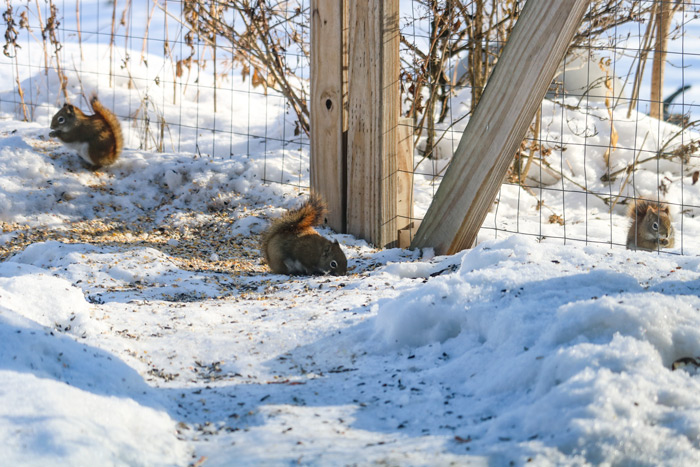
Three American red squirrels eating birdseed.

Four American red squirrels eating bird seed in the snow.
This way of providing the red squirrels with a food source has seemed to work out, that is until they begin to disagree over the territory. Here is a short video of one of these disagreements. You really need to watch this closely.
Another fascinating thing about these squirrels is the system of tunnels they have constructed to get to this food source. The squirrels made these tunnels after the snow fell recently. When the tunnels were formed, the snow was still soft, but it iced over quickly. This is pretty smart, being the usual vegetation they could otherwise utilize for camouflage has since disappeared for the season. A recent common threat to the squirrels and the birds has been the introduction of a sharp-shinned hawk Accipiter striatus to the area. I have seen this hawk kill a couple of birds in the yard and at the feeders and it is an awful thing to witness. If I see a hawk in the area, I will keep the feeders inside. I understand the ways of nature, but I hope this helps to reduce the risk of further deaths.
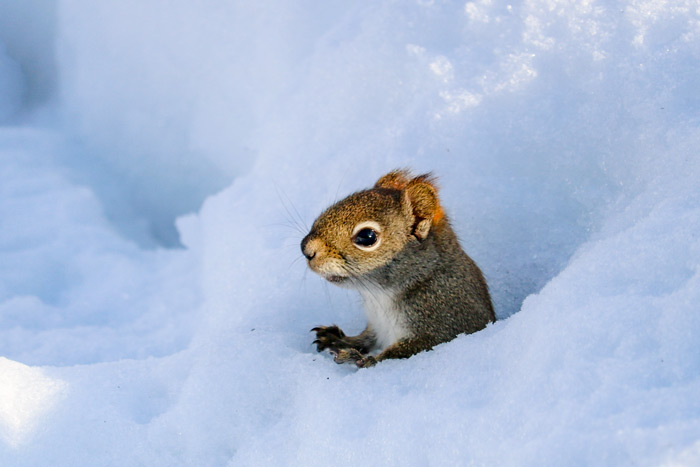
An American red squirrel coming out of its snow tunnel.

An American red squirrel standing outside of its snow tunnel.
Now for the troublemaker of the group. There is one brazen red squirrel that thinks she has a free pass when it comes to eating from the feeders. Upon closer inspection of this squirrel, I believe it is a female. I have lost count of how many times I have had to stop what I was doing and get her off of the feeders. Sometimes she acts totally shocked that she is being scolded and sometimes she just ignores me. I have had to remove the feeders with her still in them and she will jump out just before I bring them back into the house. This little dance of ours goes on almost every day. I am still bringing the feeders in at night and I’m glad these squirrels usually leave around 3 o’clock in the afternoon. This way, the birds can feed without interruption for an hour or so before it gets too dark and the feeders are back inside the house. Here are a couple of photographs of my favorite American red squirrel I love to hate. She drives me crazy sometimes, but I do enjoy watching her and the others and taking photographs of them. I believe we do in fact have a classic love/hate relationship happening here.
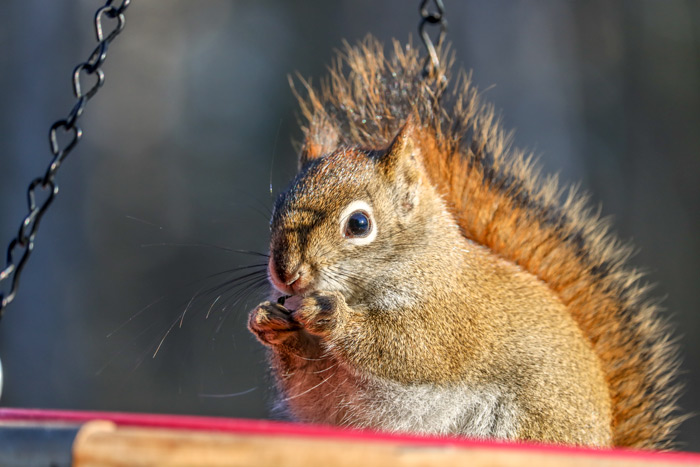
An American red squirrel in the bird feeder.
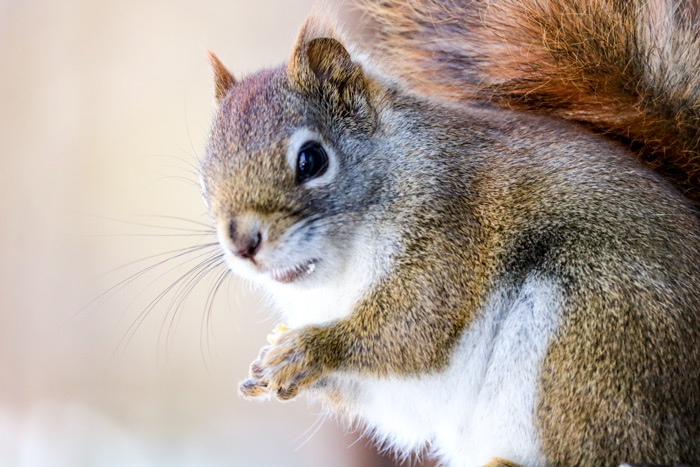
An American red squirrel eating stolen bird seed.
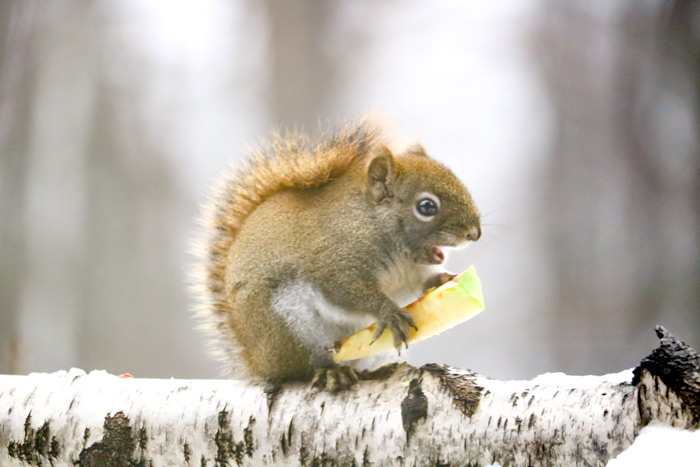
An American red squirrel eating an apple slice from the “salad bar.”
I would also like to switch gears and share some information about this species of squirrel.

The American red squirrel is one of three species of tree squirrels currently classified in the genus Tamiasciurus and the squirrel family Sciuridae, belonging to the order Rodentia.
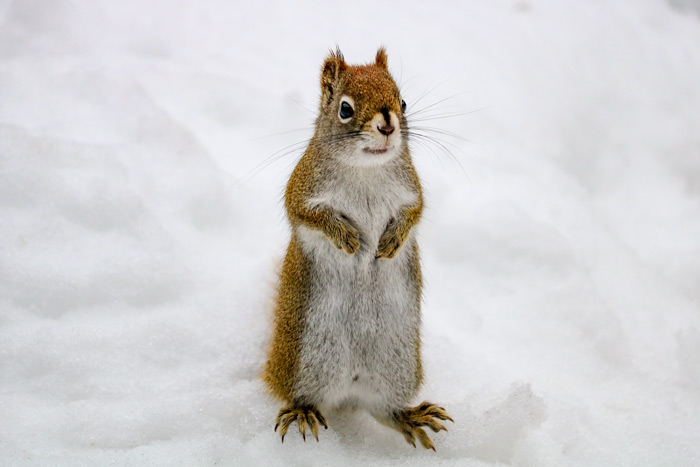
The American red squirrel is also known as the pine squirrel, North American red squirrel, boomer, fairydiddle, and chickaree.
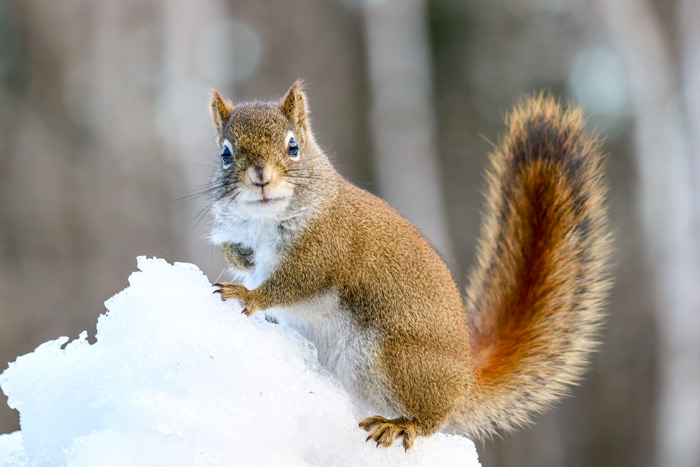
The American red squirrel is a small mammal with reddish to reddish-gray fur on top and a white or cream underside. It is 7 to 8 inches long, excluding the tail, and weighs about 5 to 9 ounces. These squirrels have white around their eyes and bushy tails. In the winter, they get tufts of hair at the tips of their ears. In the summer, these squirrels may have a black stripe on their sides. They have curved front claws and powerful hind legs, making them very good climbers and jumpers.
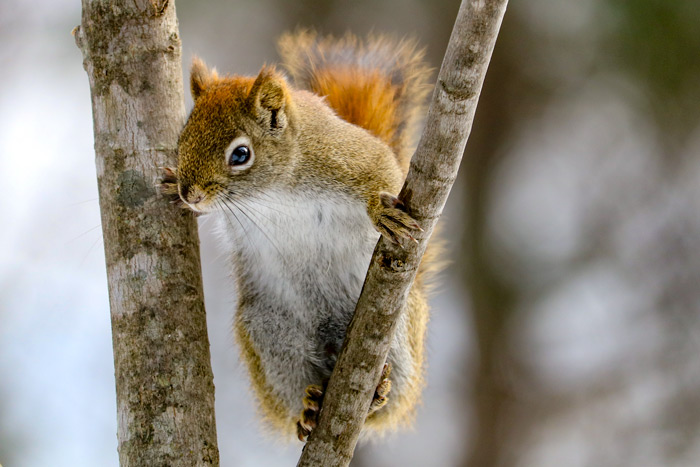
The American red squirrel is found in coniferous, deciduous, and mixed coniferous-deciduous forests.
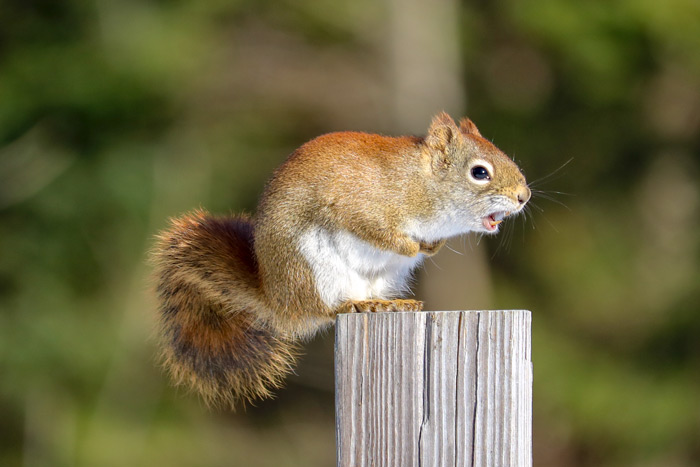
American red squirrels lead solitary lives and will aggressively defend their territory. Territories average between two to five acres. These squirrels are very vocal and they chatter, growl and screech.
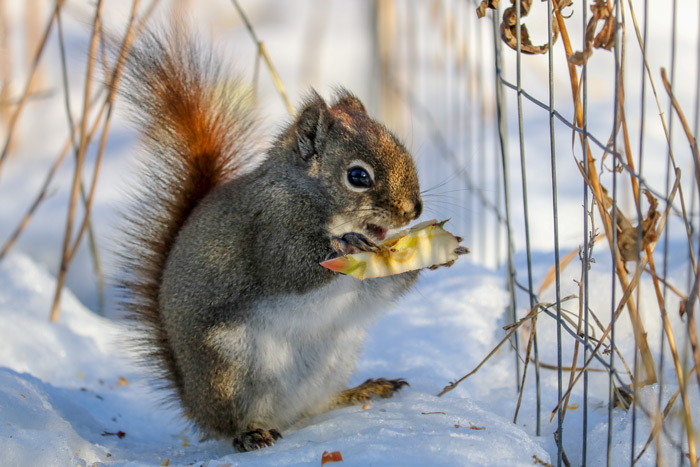
American red squirrels are primarily granivores (seed predators). A large part of their diet is made up of pine seeds. These squirrels also eat a wide variety of foods including insects, seeds, bark, nuts, fruits, mushrooms, and pine seeds or cones. They will sometimes consume insects, young birds, mice, and rabbits.
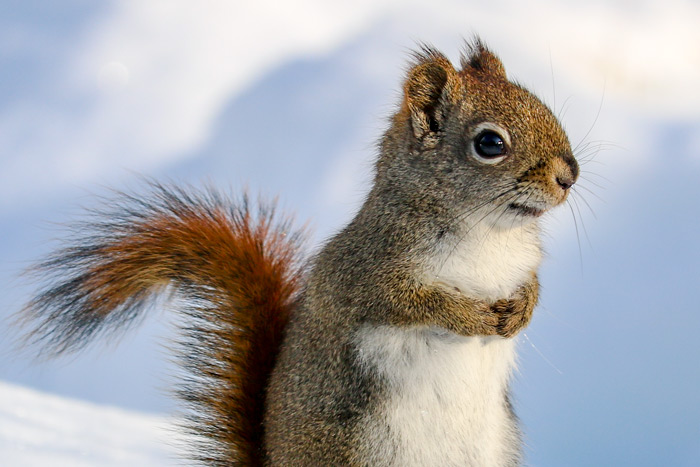
The mating season is in the late winter. American red squirrels are spontaneous ovulators. Females will enter estrus for only one day, but venture from their territory prior to ovulation. Males will compete with one another for the opportunity to mate with the estrous female. Estrous females will mate with 4 to 16 males.
These squirrels make their nests in a variety of places including hollows in the ground, tree hollows, logs, or crotches in trees. About a month after mating, the female will have a litter of between three to seven young, called kittens. Young are weaned after seven or eight weeks and will leave their mother when they are about 18 weeks old.
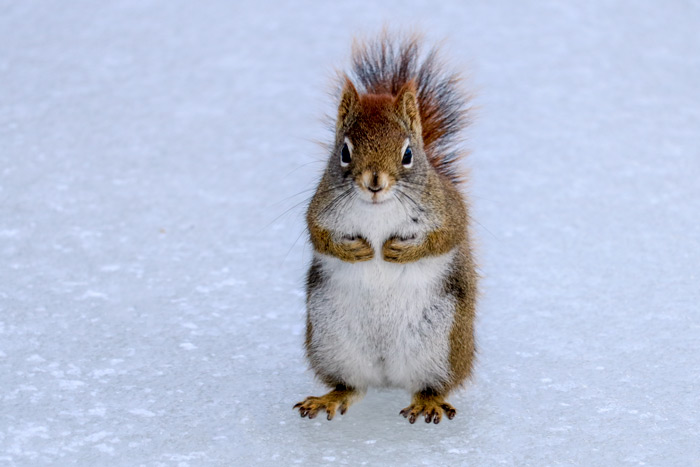
The American red squirrel is found in the Rocky Mountain states and in the eastern United States south to northern Virginia and west to Illinois, Indiana, and Ohio as well as parts of Alaska and Canada. These squirrels are not found in most of the Great Plains or in the southeastern United States, because conifer trees are not common in those areas.
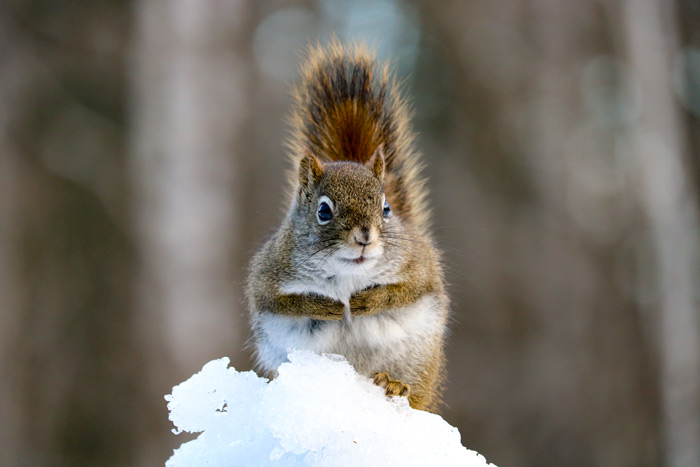
The main predators of the American red squirrel include the Canadian lynx Lynx canadensis, bobcat Lynx rufus, coyote Canis latrans, great horned owl Bubo virginianus, northern goshawk Accipiter gentilis, red-tailed hawk Buteo jamaicensis, American crow Corvus brachyrynchos, American marten Martes americana, the red fox Vulpes vulpes, gray fox Urocyon cinereoargenteus, wolf Canis lupus, and weasel Mustela sp.
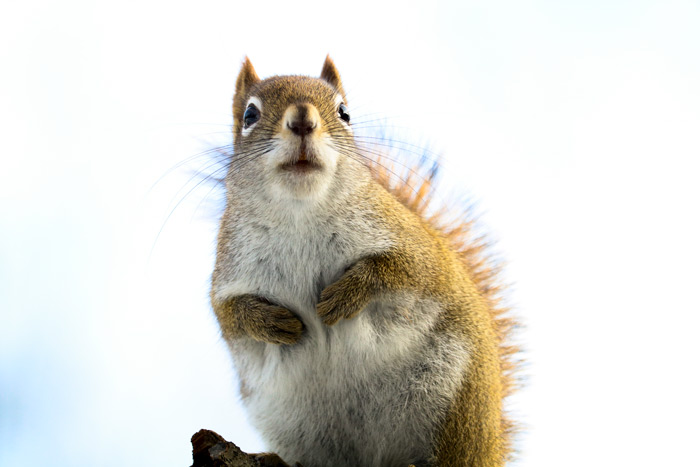
Also, did you know that January 21st is National Squirrel Appreciation Day? Although squirrels are usually considered pests, others find squirrels simply fascinating. On January 21st, National Squirrel Appreciation Day recognizes a critter some consider a pest, and others see as just fascinating. This is a day to acknowledge the role that squirrels play in nature and the environment. I suppose in honor of this day, I will make an exception and treat my visitors to some extra food…on the ground, of course!
Resource used for this post:
Guide to Animal Tracking and Behavior
Leave a Reply